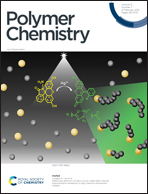Delineating synchronized control of dynamic covalent and non-covalent interactions for polymer chain collapse towards cargo localization and delivery†
Abstract
Chain collapse in synthetic polymers is an excellent approach for mimicking the natural self-folding process that imparts structural control, leading to attractive compartmental applications, e.g. drug delivery. In this regard, water-soluble and thermo-responsive polyacrylamide polymers CP1–2 with photodimerizable coumarin moieties grafted into the backbone are employed to design polymeric nanoparticles. The chain collapse can be efficiently controlled using dual response strategies involving photodimerization under UVB light (λmax = 320 nm) as well as host–guest interaction by the addition of a bis-β-CD host. The aggregation of the nanoparticles is controlled by the interplay of a lower critical solution temperatures (LCST) that can be tuned as a result of photodimerization and host–guest interaction. Further, sequential folding of the polymers is demonstrated by the addition of the host molecule followed by exposure to UVB irradiation. Such multi-stimuli-responsive compaction of size with synergistic control of non-covalent and dynamic covalent interaction and tuning of LCST render the system suitable for compartmental loading and sustainable/burst release of hydrophilic and hydrophobic cargos e.g. rhodamine B dye and the drug ibuprofen under homeostasis control.



 Please wait while we load your content...
Please wait while we load your content...